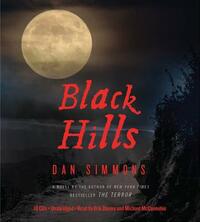You need to sign in or sign up before continuing.
Take a photo of a barcode or cover
This book is really really really very very very tedious.
I found this hard to follow and long. When it was time for it to go back to the library, I didn't feel motivated to do the kindle trick. Just couldn't get invested.
I have read a couple of Dan Simmons books and thoroughly enjoyed them (The Terror, Drood) so I was very excited when I saw this at Barnes and Noble and picked it up. The story revolves around the Dakotas and the building of Mount Rushmore. The historical figures in the book are vivid but the story seemed to drag for me. The author brought you back and forth from the protagonists youth to his elderly years and it felt really in-congruent. Interesting story but not it didn't hold my interest like The Terror and Drood.
Dan Simmons’ Black Hills takes the reader on a journey through the stormy period of transition in the Midwest, from the late 19th to the early 20th Century. Much of the books is from the perspective of a Lakota (Sioux) Indian named Paha Sapa (“Black Hills”). The cultural and historical significance of the actual Black Hills region is a common thread throughout the book - from an individual’s namesake and world to the rather abrupt transformation into Mount Rushmore.
Simmons’ story travels back and forth chronologically as Paha Sapa ages - beginning when the ghost of general George Armstrong Custer enters him during a battle. The novel is also peppered with examples of periods of transition in America’s history, including the triumphs and innovations of the 1893 World’s Fair in Chicago to the devastating impact of war, loss, and societal change.
Readers who are interested in Native American culture may appreciate the historically accurate references to the values, beliefs, art, and language of the Lakota, which are intertwined within beautiful, natural landscapes.
Simmons’ story travels back and forth chronologically as Paha Sapa ages - beginning when the ghost of general George Armstrong Custer enters him during a battle. The novel is also peppered with examples of periods of transition in America’s history, including the triumphs and innovations of the 1893 World’s Fair in Chicago to the devastating impact of war, loss, and societal change.
Readers who are interested in Native American culture may appreciate the historically accurate references to the values, beliefs, art, and language of the Lakota, which are intertwined within beautiful, natural landscapes.
Riveting! This is historical fiction ranking right up there with Ken Follett and James Michener with a fantasy twist.
Dan Simmons is one of my favorite authors for horror and supernatural. I've not read his police procedural mysteries or science fiction, but they are on Mt Git'r'Read.
Black HIlls, Paha Sapa, is the narrator of this history of his life. He as at Little Big Horn, performed in Buffalo Bill Cody's Wild West Show, and is part of the creation of Mount Rushmore.
While at Little Big Horn, he counts coup on a soldier and, to his horror, is overtaken by the ghost of General Custer, Longhair, himself. A ghost he carries with him through his lifetime through the book. This aspect doesn't distract from the story. This is, for the most part, a history of the West as seen through the eyes of Black Hills, Paha Sapa.
Paha Sapa also finds out at a young age that he has the ability to touch a person and see that person's past memories and that person's future. Because of this ability he becomes an enemy of Crazy Horse when Paha Sapa doesn't tell him what Crazy Horse wishes to know, namely information of his death. Paha Sapa runs and keeps moving and the reader follows along.
I admit to skipping portions of the book...the portions narrated by Custer, he got on my nerves, "Oh my darling Libby..." on and on ad nauseum...no campaign talk only, via letters and memories through Paha Sapa, about what erotic acts they've done and will do again when they meet again. I got tired of the lusty narration and skimmed. I began listening to "Longhair's" narration again once he got past that aspect and began 'talking' to Paha Sapa on everyday occurrences when Paha Sapa allowed him.
I was very glad I listened to this book, mostly due to the Lakota language. I'd have mangled it no end if reading it as handheld. The narrators, Erik Davies and Michael McConnohie, are wonderfully talented and the words flow easily. I would love to learn a language as lovely as this.
Five Wild West historical beans.....
Black HIlls, Paha Sapa, is the narrator of this history of his life. He as at Little Big Horn, performed in Buffalo Bill Cody's Wild West Show, and is part of the creation of Mount Rushmore.
While at Little Big Horn, he counts coup on a soldier and, to his horror, is overtaken by the ghost of General Custer, Longhair, himself. A ghost he carries with him through his lifetime through the book. This aspect doesn't distract from the story. This is, for the most part, a history of the West as seen through the eyes of Black Hills, Paha Sapa.
Paha Sapa also finds out at a young age that he has the ability to touch a person and see that person's past memories and that person's future. Because of this ability he becomes an enemy of Crazy Horse when Paha Sapa doesn't tell him what Crazy Horse wishes to know, namely information of his death. Paha Sapa runs and keeps moving and the reader follows along.
I admit to skipping portions of the book...the portions narrated by Custer, he got on my nerves, "Oh my darling Libby..." on and on ad nauseum...no campaign talk only, via letters and memories through Paha Sapa, about what erotic acts they've done and will do again when they meet again. I got tired of the lusty narration and skimmed. I began listening to "Longhair's" narration again once he got past that aspect and began 'talking' to Paha Sapa on everyday occurrences when Paha Sapa allowed him.
I was very glad I listened to this book, mostly due to the Lakota language. I'd have mangled it no end if reading it as handheld. The narrators, Erik Davies and Michael McConnohie, are wonderfully talented and the words flow easily. I would love to learn a language as lovely as this.
Five Wild West historical beans.....
A big, fat, historical potboiler, full of period detail, with a hint of creepiness. In this novel, Colorado author Dan Simmons relates the story of Paha Sapa, a Lakota Sioux with psychic abilities that allow him to absorb the past and future memories of those he touches. At the battle of the Little Big Horn, 11-year-old Paha Sapa is present at the moment of General Custer’s death and finds himself the unwilling vessel for Custer’s consciousness. With this “ghost” of his enemy knocking around inside his head, Paha Sapa bears witness to the decline of his people and some of the major events of the late 19th and early 20th centuries.
Well-researched and thoroughly readable, Simmons’ novel details the daily life and rituals of the Sioux and other tribes, and sweeps through such varied canvases as the 1893 Chicago World’s Fair, the building of the Brooklyn Bridge, and the carving of Mount Rushmore. In one particularly harrowing passage, Paha Sapa experiences an incredible Dust Bowl-era dust storm in eastern Colorado. This is one of those books that will inspire curiosity about the many subjects covered. Highly recommended.
Well-researched and thoroughly readable, Simmons’ novel details the daily life and rituals of the Sioux and other tribes, and sweeps through such varied canvases as the 1893 Chicago World’s Fair, the building of the Brooklyn Bridge, and the carving of Mount Rushmore. In one particularly harrowing passage, Paha Sapa experiences an incredible Dust Bowl-era dust storm in eastern Colorado. This is one of those books that will inspire curiosity about the many subjects covered. Highly recommended.
In a fit of whimsy, I hereby announce I will give everyone five stars, but the reviews may not reflect it.
Revenge is a dish best served cold. Paha Sapa, a Sioux, plans to exact revenge for the Battle of the Little Bighorn by blowing up Mount Rushmore when FDR comes to visit it. Paha literally has voices in his head, including his former chief and General Custer. While the story is compelling, it also portrays the treatment of Saha and his people before and after the famous battle. I didn't like the Custer sections so much, but the rest of the story was great.
Revenge is a dish best served cold. Paha Sapa, a Sioux, plans to exact revenge for the Battle of the Little Bighorn by blowing up Mount Rushmore when FDR comes to visit it. Paha literally has voices in his head, including his former chief and General Custer. While the story is compelling, it also portrays the treatment of Saha and his people before and after the famous battle. I didn't like the Custer sections so much, but the rest of the story was great.
dark
emotional
reflective
sad
tense
slow-paced
Plot or Character Driven:
Character
Strong character development:
Yes
Loveable characters:
No
Diverse cast of characters:
Yes
Flaws of characters a main focus:
No
Once I got into the book and used to the flashbacks and flash forwards I enjoyed this book. An interesting look at Little Big Horn and Mount Rushmore. I did feel the ending was a bit too pat but, it was a good read.



